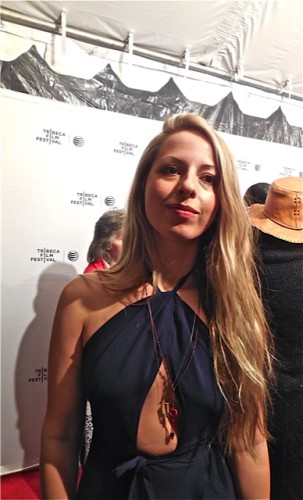
This is a guest post by Paula Schwartz.
Six brothers spent their lives cloistered inside a messy Lower East Side tenement in Manhattan where only their father had the key. Only once or twice a year were they allowed outside their claustrophobic apartment, subsidized by welfare checks their mother received from home schooling them. They spent the day watching movies. This went on for years and years. This is not the subject of some horror film. It’s a stranger-than-fiction story that is the subject of documentary, The Wolfpack.
Directed by Crystal Moselle, the documentary created a stir at Sundance where it premiered, where the brothers turned up for the screening but spoke very little with the press.
Last weekend, The Wolfpack made its New York premiere at the TriBeCa Film festival at the SVA Theater on 23d Street, not so far from where the boys spent almost all their lives inside the closed walls of their claustrophobic and unkempt apartment.

Everything that the six boys – whose surname is Angulo – knew of the world they gleaned from movies. Quentin Tarantino’s movies were favorites, along with those of Martin Scorsese, Christopher Nolan, and David Lynch. The boys – Govinda, Bhagavan, Narayana, Krisna, Jagadesh, Mukunda – spent their time watching movies and then reenacting scenes wearing costumes they created out of thrift shop clothes they retooled to resemble that of their characters.
One of the brothers described their existence as living in a prison. One sibling said they lived inside their minds.
As they got older, once or twice a year the siblings would walk in the streets. It was on one of their rare expeditions that Moselle found them. The production notes from the film said it was like “discovering a long lost tribe.” They were a vision in their waist-length hair and Pulp Fiction-inspired wardrobe, which featured a badly fitting dark suit, white shirt, and sunglasses. Over five years, Moselle gained their trust and recorded their story. She is still very protective of them.
On the red carpet, I asked the director if the boy’s father, Oscar, a Peruvian immigrant, who in the film was often drunk and ranted incoherently, had emotionally abused his sons. She replied tersely, “I’m not going to answer those questions.”
Moselle described her relationship with the brothers as sisterly, so they felt comfortable around her. (Their actual sister, to whom they are very close, is mentally disabled.)
“I watched them grow up,” Moselle told me. “There’s an incredible transformation that they went through so it was a beautiful thing to see this great transformation, and then now they’re making films in the world and socializing and happy people.”
Neither of the boys’ parents, including their mother Susanne, who seems as controlled as her sons in the film, appeared on the red carpet.
I spoke to Govinda, who is the second oldest and has a twin, what life is like now. “Life now is busy. It’s taken off cause this has pushed us to just start relationships with people, and in the filmmaking world it’s all about relationships,” he said like a pro.

“Offers are flowing in,” said the charismatic, handsome 22-year-old. “We’re starting our own production company, Wolfpack Productions. We’re working as assistants on sets, so there’s a lot happening for us. It’s opened up a lot of doors.”
The brothers still play out scenes from their movie scenes. “We’ll always do that,” Govinda smiled. “That’s the heart for us, so we’ll takes these movies with us wherever we go.”
They are still stunned by the Sundance success. “What could be more surprising and stupendous than that, the Oscars?” I asked. “You never know,” Govinda told me.
This red carpet stuff is something they’ve dreamed about since they were kids sitting on dirty mattresses watching movies, Govinda said. “This is something that we always dreamt about when we were 12 year olds and we’d turn on the TV and watch people on the red carpet and be like, ‘I want to do that some day! I want to be in front of those cameras some day and be on the red carpet!’”
The boys wore their signature outfits. “We actually thrift shop buy everything,” he told me. “We search around all New York City; we go to all the different stores and then we reference clothes from movies and this is like our Reservoir Dogs look.”
Soon, designers will be calling them and asking them to wear their suits, I told them. “That started already,” Govinda noted. They already have a fashion spread in the works. “We’re doing stuff with big magazines, so there’s a lot of talk in the works.”
Maybe because of years of being shut off from the outside world, the brothers’ speech is still a little off kilter, and Govinda speaks slowly and chooses his words carefully. I asked him how his parents were doing with all the media attention.
“They’re doing well. Dad’s more – he’s not a big public eye guy so he doesn’t like being in front of the camera and everything. You know how he was in the documentary, but mom is all for it.”
How did his Dad feel about the way he was portrayed? “We got a bunch of comments from people saying I wish I could do that to my children, in a joking kind of way,” Govinda laughed. “But my Dad, he loved the movie. The movie was an honest portrayal.”
